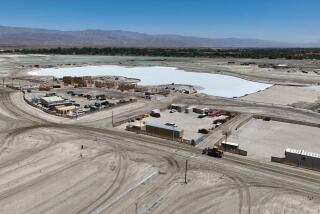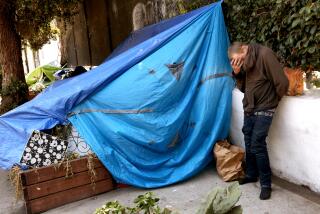All Work, No Play : Development: Villa Campesina was built with the sweat of its residents. But land set aside for a park may be claimed by the county.
MOORPARK — They are used to waiting. But the 62 families in Moorpark’s Villa Campesina neighborhood are telling city officials they don’t want to wait any longer.
First they had to wait years to qualify to move into the community. Then they spent another year building the homes themselves.
And they have had to wait almost five years, since the last home was built in 1991, for a park and playground.
But the land for the park is still vacant, and now the county Flood Control District plans to take 20% to 30% of it for a flood-control channel.
That has homeowners in the small community upset.
“We’ve waited and waited,” said Felix Gomez, who moved into the neighborhood with his wife and three children after building his home five years ago.
“We see parks go up real quick in other parts of town and it’s no big deal. This one has been postponed and postponed,” he said. “Maybe somebody just doesn’t want it, but we’re not going to let them take that park away from us.”
Villa Campesina has been a unique place from the start. The homeowners were drawn from working poor and lower-middle-class families, who would not have been able to afford a home on their own.
With help from the federal government, private organizations, the city and the Catholic church, the families were given an opportunity to build their own homes.
The small community close to the city’s downtown was built with “sweat equity.” Each family put in about 10 months, pouring foundations and hammering nails on evenings and weekends. They each worked in groups building their own homes and the homes of 10 of their neighbors.
Work on the first home began around Thanksgiving in 1989 and the last was finished in 1991.
The park was to be built within two years of the completion of the neighborhood. Many of the homeowners who live there have large families and immediately saw the need for a place for their children to play other than the streets.
They each contributed about $800 for the park and now have about $40,000 in the bank for the project. It may take another $100,000 to build, but they have pledged to raise the money through donations and corporate sponsors. The families also helped design the park, and they plan to build most of it themselves.
Plans for the park call for a basketball court, a playground for small children, playing fields for soccer and volleyball, and a picnic area. Once completed, it would be turned over to the city.
“Last fall, we were real close to starting the grading,” said Christine Adams, director of Moorpark’s Community Services Department.
Instead, the Ventura County Flood Control District put the project on hold while it studied the area.
In July, the district notified the city and the Cabrillo Economic Development Corp., the Saticoy-based nonprofit group that helped the residents build the homes, that it would take a portion of the land for flood-control purposes.
The channel will be widened, and the area has also been selected for a wetlands restoration.
“It’s a real shame but I don’t think they really leave enough room for much more than half a basketball court,” Adams said. “It’s too bad because there would have been a lot of pride there. The people planned it and they were going to build it themselves. I think they would have kept it clean and well cared for.”
Neighbors are frustrated by the news. Melissa Harris, who lives with her husband and five children two houses away from the park’s planned location, said she and her neighbors don’t plan on just giving in to the county’s plans.
“They can restore some other part of the arroyo,” Harris said. “I think if I hadn’t made a call, no one would have told us about it. They thought we were just a bunch of low-income families that are mostly Hispanic and that we would keep quiet.”
Instead, Harris, Gomez and several of their neighbors have been making phone calls. The homeowners appeared before the Moorpark City Council on Wednesday, and the council gave them a commitment to look into the matter.
“I even called Cardinal [Roger] Mahony,” Harris said. “We’re going to do everything we can. These kids need a place to play.”
More to Read
Sign up for Essential California
The most important California stories and recommendations in your inbox every morning.
You may occasionally receive promotional content from the Los Angeles Times.










